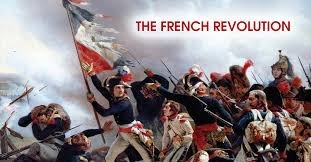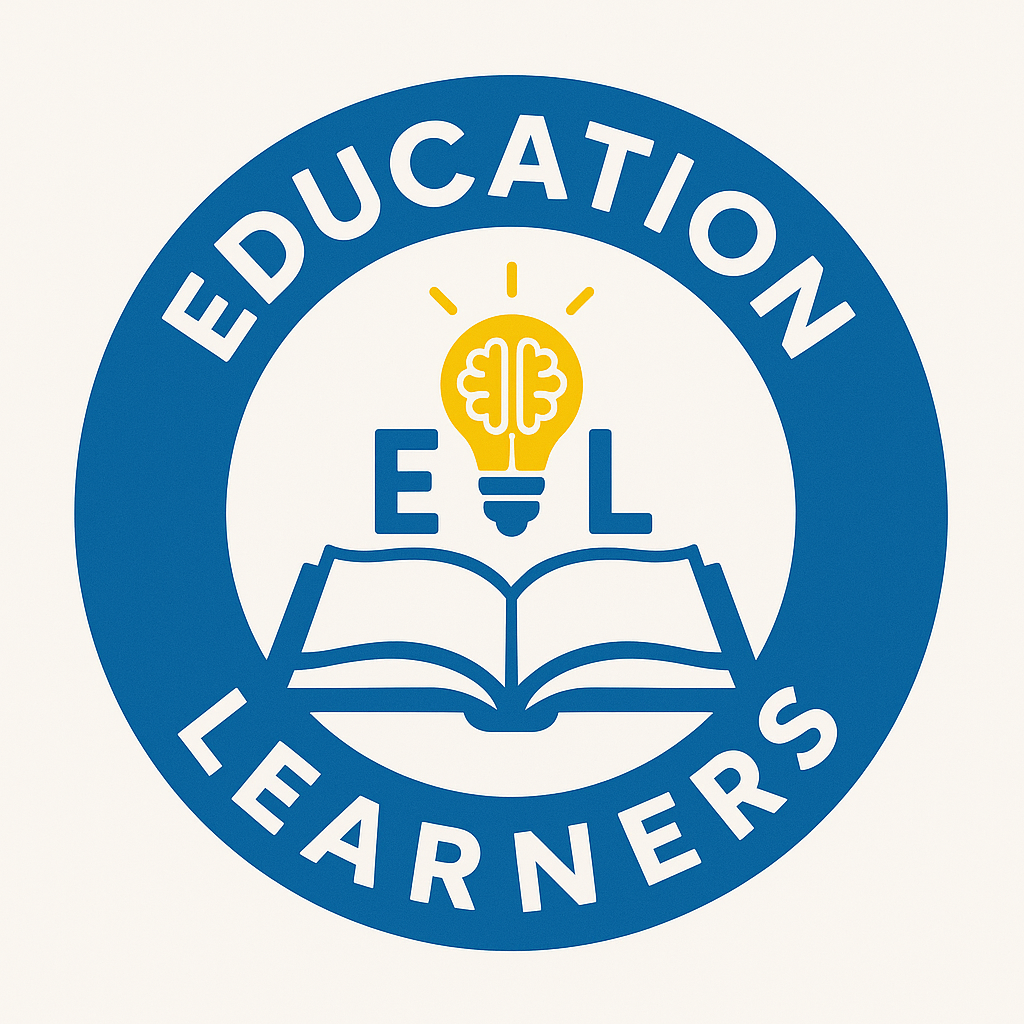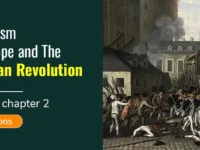
Easy Notes (Short Summary + Key Points)
1. Introduction
The French Revolution began in 1789. It ended the absolute monarchy and brought ideas of liberty, equality, and fraternity.
Summary in 60–70 Words: The French Revolution started in 1789 due to injustice, inequality, and absolute monarchy. The Third Estate suffered under heavy taxes while the clergy and nobles enjoyed privileges. Enlightenment thinkers and rising bread prices increased public anger. People stormed the Bastille prison, and later King Louis XVI was executed. The revolution introduced democracy, ended feudalism, and spread the ideals of liberty, equality, and fraternity across the world.
2. French Society (Before 1789)
- Divided into 3 Estates:
1st Estate – Clergy (privileged)
2nd Estate – Nobility (privileged)
3rd Estate – Common people (tax payers) - Third Estate faced heavy taxes, no rights
3. Causes of Revolution
- Social inequality
- Economic crisis
- Influence of Enlightenment thinkers
- Extravagant spending by King Louis XVI
- Rising bread prices → people’s anger
4. Events of the Revolution
- 14 July 1789: Storming of Bastille prison (symbol of king’s power)
- 1791: Constitution of France
- 1793: King Louis XVI executed
- 1793–94: Reign of Terror under Robespierre
- Later, Napoleon Bonaparte took over
5. Impact of the Revolution
- End of monarchy and feudalism
- Rise of democratic ideas in Europe
- Declaration of Rights of Man
- Modern citizenship and equality promoted
Multiple Choice Questions
- When did the French Revolution begin?
a) 1776
b) 1789
c) 1791
d) 1804 - The Bastille was a symbol of:
a) Liberty
b) Equality
c) Royal authority
d) Democracy - Which estate paid all the taxes in France before the revolution?
a) First Estate
b) Second Estate
c) Third Estate
d) Nobles - Who wrote the ‘Social Contract’?
a) Voltaire
b) Locke
c) Montesquieu
d) Rousseau - What is the significance of 14 July in France?
a) Independence Day
b) End of monarchy
c) Bastille Day
d) Republic Day - What was the name of the French Constitution made in 1791?
a) Constitution of Monarchy
b) Constitution of Equality
c) Constitution of France
d) National Constitution - Who was the king during the French Revolution?
a) Louis XIV
b) Louis XVI
c) Napoleon
d) Charles X - What was the Reign of Terror?
a) Rule of Napoleon
b) Period of Robespierre’s strict control
c) Time of peace
d) Economic growth period - Which document declared rights of men and citizens?
a) French Constitution
b) National Pact
c) Declaration of Rights of Man and Citizen
d) Civil Code - Who took power after the fall of Robespierre?
a) Jacobins
b) National Assembly
c) Napoleon Bonaparte
d) Louis XVI - Which class included lawyers, teachers, and merchants?
a) First Estate
b) Nobility
c) Bourgeoisie
d) Monarchy - What was guillotine used for?
a) Cooking
b) Farming
c) Execution
d) Construction - Which of the following was a political club during the Revolution?
a) Jacobins
b) Girondins
c) Both a and b
d) National Guard - What is ‘fraternity’?
a) Brotherhood
b) Liberty
c) Equality
d) Monarchy - What was the role of women in the French Revolution?
a) Passive
b) Demanded rights and education
c) Supported monarchy
d) Remained silent
Assertion and Reason Questions
Q1. Assertion (A): The Bastille was stormed on 14 July 1789.
Reason (R): It was the prison where the king stored weapons.
a) Both A and R are true, and R is the correct explanation of A.
b) Both A and R are true, but R is not the correct explanation of A.
c) A is true but R is false.
d) A is false but R is true.
Q2. Assertion (A): The Third Estate was angry before the revolution.
Reason (R): They paid all the taxes and had no privileges.
a) Both A and R are true, and R is the correct explanation of A.
b) Both A and R are true, but R is not the correct explanation of A.
c) A is true but R is false.
d) A is false but R is true.
Q3. Assertion (A): Robespierre introduced reforms to protect the revolution.
Reason (R): He wanted to create a republic of virtue.
a) Both A and R are true, and R is the correct explanation of A.
b) Both A and R are true, but R is not the correct explanation of A.
c) A is true but R is false.
d) A is false but R is true.
Q4. Assertion (A): The Reign of Terror was a peaceful time.
Reason (R): Robespierre promoted freedom and equality.
a) Both A and R are true, and R is the correct explanation of A.
b) Both A and R are true, but R is not the correct explanation of A.
c) A is false but R is true.
d) Both A and R are false.
Q5. Assertion (A): Napoleon introduced the Civil Code.
Reason (R): It limited the privileges of the aristocracy and ensured equality.
a) Both A and R are true, and R is the correct explanation of A.
b) Both A and R are true, but R is not the correct explanation of A.
c) A is true but R is false.
d) A is false but R is true.
Case-Based Study Questions
Case Study 1: Read the passage below and answer the following questions:
In 1789, France was facing severe food shortages, high taxes, and an unfair social structure. The Third Estate, which made up 98% of the population, had no privileges. The storming of the Bastille was a turning point in French history.
- Why was the Third Estate angry?
- What happened on 14 July 1789?
- What was Bastille a symbol of?
- Which estate paid all the taxes?
- Name one major result of the French Revolution.
Case Study 2: The Reign of Terror (1793–94) under Robespierre was a time when many people were executed. Robespierre believed only harsh laws could protect the revolution.
- Who led the Reign of Terror?
- Why did Robespierre use harsh punishments?
- What was the guillotine used for?
- When did the Reign of Terror end?
- What happened after Robespierre’s fall?
Case Study 3: The National Assembly passed the Declaration of the Rights of Man and Citizen in 1789. It promoted liberty, equality, and justice.
- What was the goal of the Declaration?
- Which Assembly passed it?
- Which ideas were promoted by the Declaration?
- When was it passed?
- How did it impact France?
Case Study 4: Women played a major role in the French Revolution. They demanded equal rights, education, and bread. Many marched to Versailles and joined political clubs.
- What did women demand during the Revolution?
- Where did they march for bread?
- Name one club they formed.
- Were their demands fully accepted?
- What long-term impact did their efforts have?
Case Study 5: Napoleon Bonaparte rose to power after the fall of Robespierre. He introduced the Civil Code, brought stability, and later crowned himself emperor in 1804.
- Who became ruler after Robespierre?
- What was the Civil Code?
- In which year did Napoleon become emperor?
- Was Napoleon a dictator?
- Did his reforms impact Europe?
Long Answer Questions
Q1. What were the main causes of the French Revolution?
The French Revolution began in 1789 due to social inequality, economic hardship, and the absolute monarchy of Louis XVI. The Third Estate faced high taxes and had no political rights. Enlightenment thinkers like Rousseau and Voltaire inspired revolutionary ideas. Rising bread prices, debt from wars, and unfair privileges to nobles added to public anger.
Q2. What was the significance of the storming of the Bastille?
On 14 July 1789, angry citizens stormed the Bastille prison, a symbol of the king’s power. It marked the start of the French Revolution and the fall of monarchy’s fear. The people wanted weapons, justice, and freedom. Bastille Day is now celebrated in France as a national festival, symbolizing freedom from oppression.
Q3. What was the role of the National Assembly in the French Revolution?
The National Assembly, formed by the Third Estate, worked to create a constitutional monarchy. It abolished privileges of the clergy and nobility, and passed the Declaration of the Rights of Man and Citizen, which gave rights like freedom, equality, and justice to all. It made the king answerable to a constitution and gave power to the people.
Q4. What do you know about the Declaration of the Rights of Man and Citizen?
Passed in August 1789, the Declaration of the Rights of Man and Citizen was a historic document that promised freedom, equality, and fraternity to all citizens. It stated that all men are born free and equal, and every person has the right to liberty, property, and security. It became the base of French democracy and inspired future revolutions.
Q5. Who was Robespierre? What was the Reign of Terror?
Robespierre was the leader of the Jacobins during the Reign of Terror (1793–94). He believed in strict laws to protect the revolution. He executed many people using the guillotine, including nobles and even revolutionaries. His rule was harsh and full of fear. After his fall, France ended this terror and formed a more moderate government.
Q6. What were the results of the French Revolution?
The French Revolution led to the end of monarchy and feudalism. It brought equality before law, liberty of speech, and right to property. New ideas of citizenship and democracy emerged. The Revolution inspired people across the world to fight against injustice. It gave birth to modern political thinking and the demand for people’s rights.
Q7. Describe the condition of the Third Estate before the Revolution.
The Third Estate included peasants, workers, and the middle class. They had to pay all the taxes while the First and Second Estates enjoyed privileges. They had no voice in government and lived in poverty. Bread was expensive, and jobs were scarce. This injustice and inequality made them angry and they demanded change.
Q8. What was the role of women in the French Revolution?
Women participated actively in the French Revolution. They marched to Versailles for bread, joined clubs like the Society of Revolutionary Women, and demanded equal rights, education, and voting rights. Though their demands were not fully met, they helped spread the ideas of equality and freedom, and laid the foundation for future women’s movements.
Q9. How did the French Revolution inspire other countries?
The ideas of the French Revolution — liberty, equality, fraternity, and justice — inspired revolutions in Europe, Latin America, and Asia. People in other countries began to fight against monarchy, colonization, and social injustice. Revolutionary leaders in many nations used the French example to gain independence and establish democratic governments.
Q10. Who was Napoleon Bonaparte? What was his role after the revolution?
Napoleon Bonaparte was a French army general who rose to power after the revolution. He ended the Reign of Terror, brought stability, and crowned himself emperor in 1804. He introduced the Napoleonic Code, which gave legal equality and abolished feudal laws. Although he became a dictator, his reforms had a lasting impact across Europe.
SearchSearch



